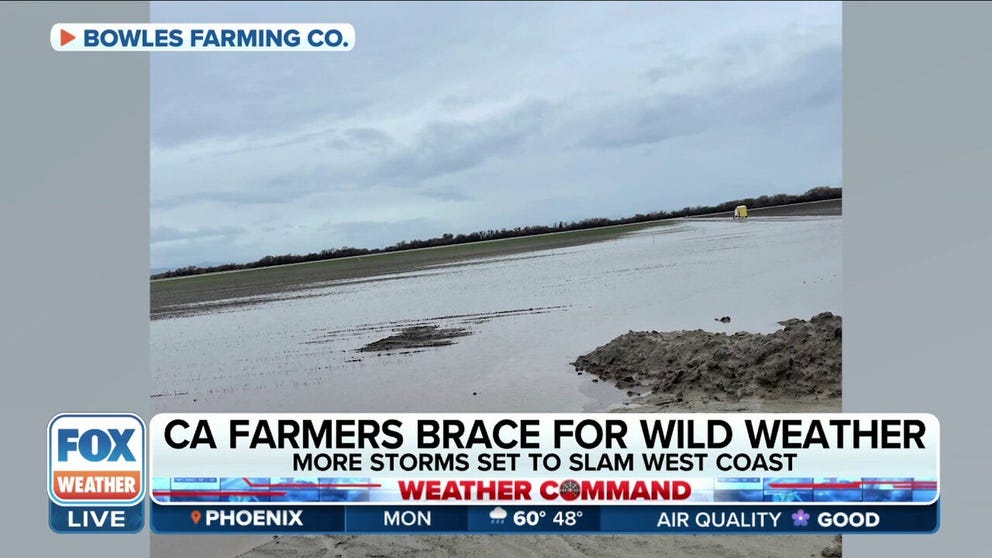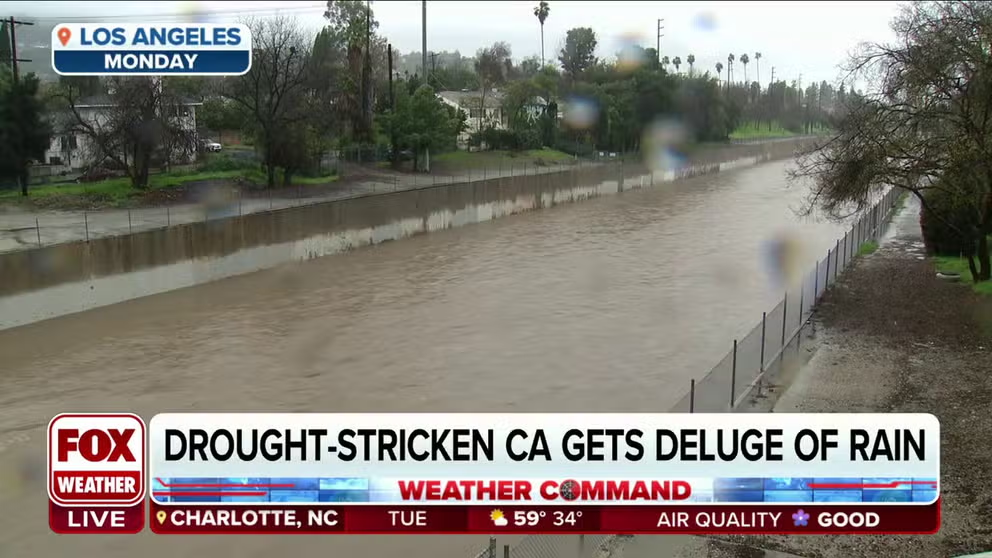'Out of our control': California farmers struggle after recent atmospheric rivers
After three years of drought, the skies opened up over California farms, and now crops are under water. One farmer said that he can work around extremes but needs a longer-term solution to the feast and famine.
Weeks of rain having little impact on disruption of seeding for California farm
Derek Azevedo, Executive Vice President of Bowles Farming Company, talks about how flooding has had little impact on his farm on disrupting any seeding for crops.
LOS BANOS, Calif. – California will finally get a break from the parade of atmospheric river storms late week, but it might be too late for some crops. Some farmers are working to deal with the consequences of the excess rain.
"We didn't get all the carrots planted quite where we wanted to," said Derek Azevedo, Executive Vice President of Bowles Farming Company. "We've got a little bit of disruption in onions."
But the executive with the 6th generation farm company in California’s Central Valley didn’t seem too concerned about the weather.
DRAMATIC IMAGES SHOW DEVASTATION FROM ONSLAUGHT OF ATMOSPHERIC RIVERS SLAMMING CALIFORNIA

Large portions of the Bowles Farms are underwater and the roads impassible.
(STAN AZEVEDO / FOX Weather)
"Most farmers in California pay close attention to history. None of us are surprised by this," Azevedo said. "California has a long, deep history of having extended periods of dry times and then extended periods of wet times."
He said that this weather will not be a problem for summer crops like nuts, tomatoes and cotton, which account for most of the farms' output. Water storage does have him concerned, though.
"What the real story here is, whether it's wet or dry, having the ability to store this water for when we need it in the summertime is what's really impactful," said Azevedo of the volume of the storm runoff instead of capture. "You know, there's more water going underneath the Golden Gate Bridge right now than following in the Mississippi River."

The Oroville Dam spillway at Lake Oroville during a drought in Oroville, California in 2021.
(David Paul Morris/Bloomberg / Getty Images)
"Some of the most important reservoirs for us are only running at 30% capacity right now," he continued. "And I think that's one of the things that, despite the fact that we're seeing all these floods, we're still in a severe drought right here."
FOX News Correspondent William La Jeunesse looked into claims like this one while atmospheric river storms pounded the state in early January. He told FOX Weather that the infrastructure is antiquated and can't deal with changing weather patterns.
"What experts will tell you is we're basically in this transition period. From the thirties to the 1960s, we built Oroville, Shasta, Coolidge Hoover to store all that water," he said, referring to large dams and reservoirs across the West. "But now, because we're not getting the same precipitation with any kind of regularity that isn't working anymore. So they now want to use the aquifer and store that water underground. But we're about 30 years behind schedule."
Drought-stricken California gets deluge of rain from atmospheric rivers
Drought-stricken California is getting a deluge of rain from atmospheric rivers hitting the state. Fox News Correspondent William La Jeunesse reports from Los Angeles.
La Junesse said that about 80% of the rainwater bypasses the reservoirs and drains into the Pacific.
"If we have the ability to manage the water as it flows through reservoirs, flows through those systems. It’s not just for farmers, whether we're managing that for the environment, managing that, or for flood protection," Azevedo explained.
'EXTRA WINTER'S WORTH OF PRECIPITATION' NEEDED TO BUST CALIFORNIA DROUGHT, SCIENTIST SAY
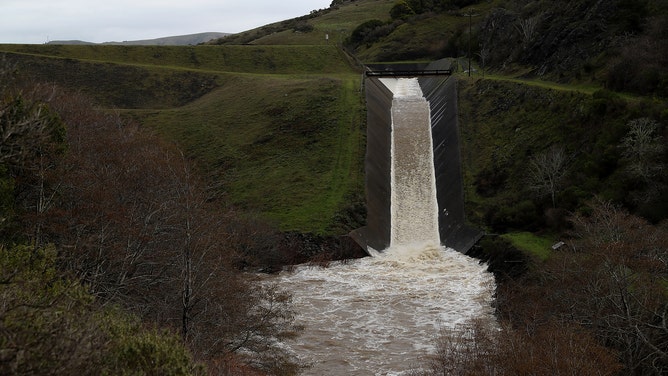
Water pours down a spillway out of Nicasio Reservoir in 2017 after a series of storms ended the drought.
(Justin Sullivan / Getty Images)
"Any extreme weather is never good for farmers. There are so many things that are already out of our control," continued Azevedo. "So any time we get a chance to manage something, it just helps provide the consistency in the products that our customers are expecting."
The last three years of drought forced Bowles Farms to take some water-needy plants out of production. Instead, Azevedo planted fewer acres of fruits like tomatoes. He told FOX Weather last year that he reduced the crop by about 10%.
HIGH GROCERY BILL? BLAME THE WEATHER
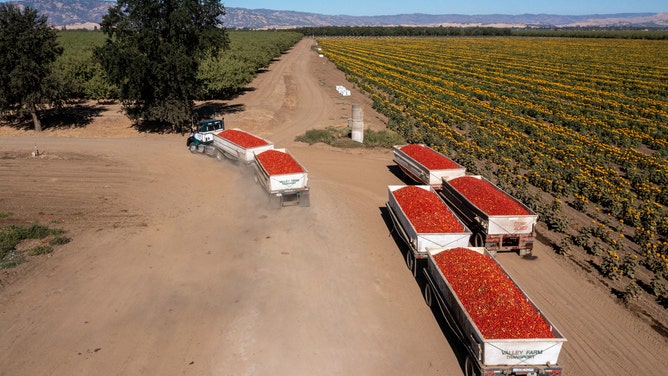
File: A tomato harvest in Winters, California in 2022.
(David Paul Morris/Bloomberg via Getty Images / Getty Images)
"We’ve adapted the crops we've grown, we've adapted our management practices, and we've adapted the equipment we use continuously over the last 165 years," Azevedo said of himself and the six generations of Bowles family that came before. "You don't get a chance to farm for 165 years without being creative, being nimble and being a problem solver."
The most recent U.S. Drought Monitor still shows 95% of the Golden State in drought. Less than 1% of the state is in severe drought.
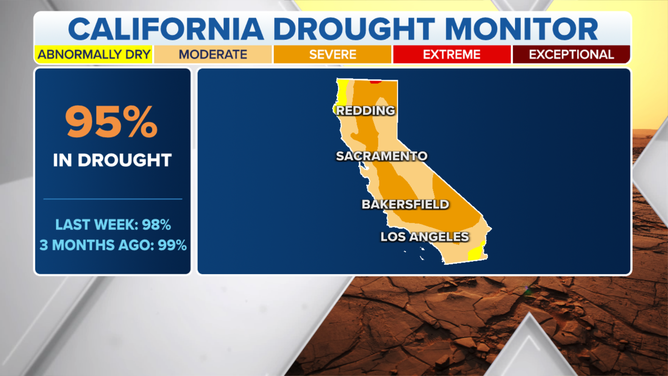
The latest U.S. Drought Monitor shows 95% of California remains in drought, but that's an improvement over last week's 98% drought coverage in the state.
(FOX Weather)
"The reservoirs, of course, is the big issue for most of what goes on in most of California, and water management is pretty heavy," Rich Tinker, the U.S. Drought Monitor author with the National Oceanic and Atmospheric Administration, said. "So, it takes a long time for reservoirs to deplete, and it also takes a while for them to refill. So, we're doing considerably better. We're still not even up to what's normal for this time of year, however."
California water restrictions will stay in place in the meantime.
The Central Valley occupies only 1% of the nation's farmland but produces a quarter of the nation's food, according to the U.S. Geological Survey. Over a third of the nation's vegetables and two-thirds of the nation’s fruits and nuts come from California.
